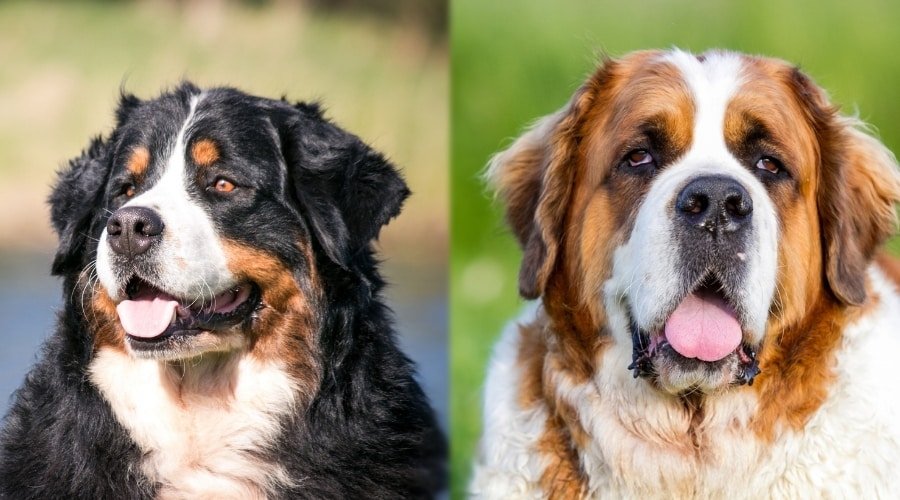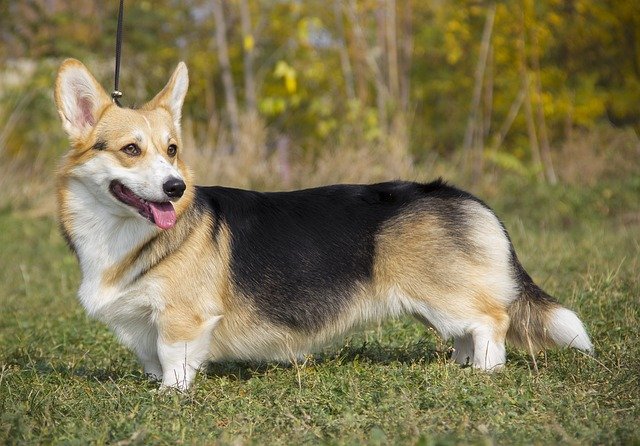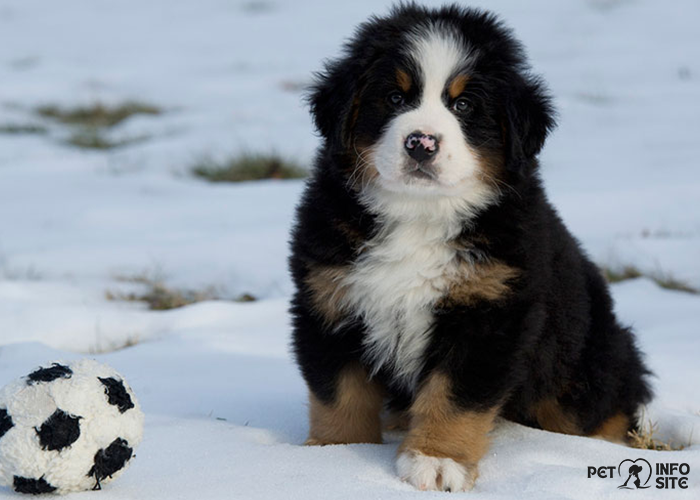A Comparative Study of Saint Bernard vs Bernese Mountains Dogs Two Dog Breeds (Bernese mountain dog vs Saint Bernard dog)
Are you struggling to decide between a St. Bernard and a Bernese Mountains Dogs as a prospective animal? Let’s begin by looking at the differences between each of these elegant greats to help you make an informed decision.
The Swiss Alps are where the Bernese Mountains dog got its start. And was bred to help with animals for consumption. When there was a lot of snowfall in the winter. They were renowned for herding sheep and cattle into buildings. The St. Bernard species continues to be used as a kind of rescue dog for many years. This variety of dogs can lift massive objects because of its enormous, massive muscles. To assist them survive in inclement weather like rain or snow. St. Bernards have thick coats that absorb rainwater.
Although both the St. Bernard and the Berners Mountain Dog are powerful canines. Renowned for their extraordinary working abilities. There are some notable differences between these two breeds. When choosing which of the two kinds of family dogs would be ideal for how you spend your time. It is crucial to understand their distinctions. Discover which among those well-known breeds might make the ideal puppy. For your preferred way of life by reading on.
Key Differences Physical Distinctions between Saint Bernards and Bernese Mountain Dogs
Following is an in-depth assessment of the physical attributes of the St. Bernard. And the Bernese mountain dog:
The Bernese Mountains Dog
- Dimensions: 58–71 cm, or 23–28 inches
- Weight range: 32–52 kg (70–115 pounds)
- Cover: Tricolored (black, white, and rusty), lengthy and smooth
- Life expectancy: 6–8 years
Dog St. Bernard
- Dimensions: 68-90 cm, or 27-35 inches
- Weight range: 54–82 kg (120–180 pounds)
- Cover: White with orange or red brindle markings, affectionate. Either long or short, and smooth or rough in texture.
- Durability: 8–10 years
Size Comparison: Bernese Mountain Dog vs Saint Bernard breed puppy
Considering the physical attributes listed above. The St. Bernard is larger than the Bernese Mountain Dog. Although the two types of dogs can grow to comparable elevated positions. The St. Bernard can weigh up to 65 pounds more than the Bernese. This is because St. Bernard was once used as a rescue animal. Requiring them to be large and robust to carry large objects. And withstand extreme conditions to socialize.
Bernese Mountain Dogs versus St. Bernard Temperament
The Bernese Mountain Dog
- Committed and loving
- Fantastic with kids and other animals
- Capable of being reserved with strangers, smart, and trainable
Bernard, St.
- Kindly and loving
- Outstanding with kids
- Calm and relaxed
- Obstinate and self-reliant at times
The Bernese Mountain Dog is recognized for being more quiet. And guarded with strangers, whereas St. Bernard is known for having easygoing behavior. And a desire to make friends with everyone they encounter. Despite this, the two types are known for their sweet natures and love of families.
Bernese Mountain Dogs versus St. Bernards Instruction and Fitness Breed Comparison
Bernese Mountain Dogs
- Needs moderate physical activity.
- Enjoys playing and going on hikes.
- Reacts to instruction via constructive reinforcement
St. Bernard
- Minimal to moderate physical demands
- Can develop laziness if not engaged in enough activities
- Often obstinate and challenging to train
While frequent exercise is necessary for both breeds to maintain good health. St. Bernards tend to be less energetic and lively than Bernese Mountain Dogs. While the St. Bernard can be harder to train and requires more time and perseverance. And determination in training, the Bernese breed also responds. Well to training with positive reinforcement.
Bernese Mountain Dogs versus St Bernards Look and Groom
These enormous dog breeds are alike, with the characteristic Swiss hues shared by all. The smaller Berner is between 23 and 27 ½ inches taller and weighs between 70 and 115 pounds. The Saint Bernard is larger, standing 26 to 30 inches tall. And weighing approximately 120 and 180 pounds. The dog gorgeous breeds people select are determined by this size discrepancy.
The Saint Bernard is said to have sad-looking features and droopier cheekbones. This is partially due to his enormous jowls, which strain on the skin furry surrounding his eyes. Both of them are attractive canines with large paws, strong bodies, and plump rectangular noses. We would describe it more as a “dad bod” than as carved muscle daily exercise.
Bernese Mountain Dogs versus St. Bernards Well-being
Though they have shorter lives than other dog breeds, both breeds of working dogs are generally healthy. This is because of their enormous size. Their median lifespans are seven to ten and eight and eleven years, depending. They share many health problems, thus if they’re supposed to be crossed over, they need to be checked for the circumstances that follow. Make careful to ask established breeders to show you their health clearances better choice.
Both of the Saint Bernard and the Berner breeds are at risk of hip and elbow dysplasia. They also have a higher risk of developing eye diseases, the condition, of entropion, and progressively retinal degeneration. Lastly, they are both susceptible to cardiac diseases, specifically the condition known as dilated cardiomyopathy. Furthermore, a disease of Von Willebrand’s screening should be performed on the Bernese Mountain Dogs.
Nourishment of Bernese mountain dog vs St Bernard
The Berner will drink between three and four cups of food each day, whereas the Saint Bernard will drink about six pieces. This can occasionally double the cost of food, depending on how much is changed. If you decide to adopt the Saint Bernard, then money is a major factor to take into account. Their years of age, size, and level of energy all affect what they eat.
Both of them will thrive on premium feed. They will give your large giant dog breeds a nutritious diet and be appetizing enough to inspire them to eat. They need to be fed food intended for gentle giant breeds because they are giant dogs. Given that they contain the ideal amounts of both calcium and phosphorus during their maturation phases. this is vital. This will lessen the likelihood that they may experience skeletal illnesses such as joint dysplasia by regulating the fast formation of bones.
Grooming of Bernese mountain dog vs St Bernard
The type of coats a Saint Bernard wears determines the differences in their maintenance routine. He will only require brushing a couple of times a week over the year if he has a short haircut dogs love.
It will require two or three weekly brushings if you acquire one with a thicker coat, akin to that of a Bernese Mountain Dog. Generally speaking, a Saint Bernard will shed roughly the same quantity of high-energy as a Berner grooming needs.
They both have two coats, and they both shed in the same way all year round. To properly control their dropping during shedding seasons, you must remember to brush them both most days. Both of these species drool a lot, so if you don’t like that, neither of them is for your energy levels.
Every eight to twelve weeks, one bath is required for both breeds. Similar to this, because of how thick and glossy their coat is, they will gain from a powerful moisturizing shampoo. They both have different issues with their eyes, so be sure to watch them and notice any modifications or redness.
Conclusion
In conclusion, selecting between a St. Bernard and a Bernese Mountains Dogs are easy requires a thorough evaluation of several aspects, including the dogs’ personality, physical characteristics, requirements for training, level of development, and general well-being.
In terms of size, the St. Bernard is often bigger than the Bernese Mountains Dog, weighing significantly more and having a more diverse coat. The St. Bernard has a white silky coat with either red or orange brindle markings that vary in length and appearance, but the Bernese Mountains Dog, which originated in the Swiss Alps, has a multicolored, long, and glossy coat.
The St. Bernard has low to modest demands on mobility but may be relatively difficult to train, whereas the Bernese Mountain Dog, or Bernese Mountain has minimum to moderate physical needs and responds effectively to constructive reinforcement socialization.
FAQs
What are the main morphological distinctions between St. Bernards and Bernese Mountain Dogs?
The Bernese Mountains Dog has a lengthy glossy coat that is tricolored, but the St. Bernard is noticeably larger and has white hair with brindle markings. Their differences in coat and size are a reflection of their adaptations to their surroundings and historical functions.
What differences do their personalities have?
Bernese Mountains Dogs are intelligent and trainable dogs that are renowned for being more reticent around strangers. On the other hand, St. Bernards have a laid-back and gregarious disposition that makes them get along with anybody they meet.
What about the necessity for exercise and instruction?
Bernese Mountains Dogs benefit from encouraging behavior during training and need a reasonable amount of physical exercise. Although St. Bernards have low moderate to high physical requirements, training them can be more difficult and require a greater amount of persistence and time.
What are the requirements for grooming?
The St. Bernard’s grooming regimen may differ depending on the length and thickness of their coat, but both breeds require frequent brushing and infrequent washes. Both breeds are also prone to hunger, so it’s important to keep a lookout for any possible problems with their eyes.
Are there any health concerns for either breed?
In addition to having shorter lifespans usually 7 to 10 years both Bernese Mountains Dogs and St. Bernards are prone to hip and elbow malformations, eye conditions, and cardiac problems like coronary artery disease. Potential owners ought to ask breeders about their health certifications.







